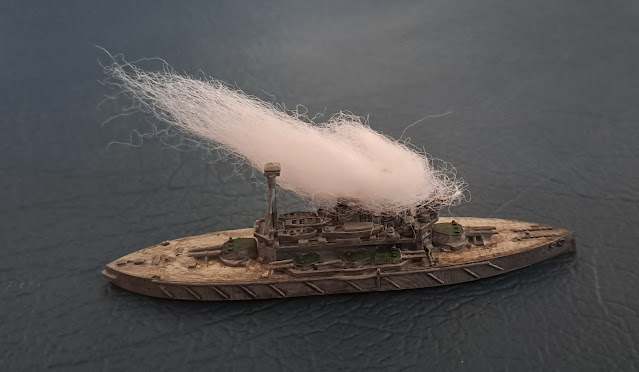Coming in at a mighty 75mm we have the last of the pre-Dreadnought battleships, HMS Lord Nelson. A 3d design from War Times Journal and printed by Karl.
One Sided Miniature Wargaming Discourse
Friday, April 4, 2025
HMS Lord Nelson 1/1800
Burgundian Ordonnace versus New Kingdom Egyptians
In getting ready for the club's next Impetus tournament, I wanted to demonstrate to Karl the killing power of medieval armies. As it turned out it was a near run thing, but my knights fought splendidly.
Thursday, April 3, 2025
Jutland
After our practice game we started on Jutland proper, having selected some optional and advanced rules, namely U-boats and British sweep. I was in favour of the latter as it seemed in keeping with the actual battle. The U-boats was more a balancing exercise.
I started the sweep late. U-boats started early and so our initial moves found nothing. As 30 May 1916 progressed the Germans quickly discovered that the Grand Fleet had combined into one Task Force. There was then a race and chase back to the German home port.
Richard, who commanded the High Seas Fleet provided the following descriptive text:
It was late afternoon on Tuesday, May 30th 1916. The sun was low in the western sky as strands of light stabbed at the grey sea below through the scattered clouds which danced in the last glorious days and hours of Spring.
At 1800, precisely, Fähnrich zur See Steinhoff had taken his position as officer of the watch in his uncomfortable nest that would be his world for the next 8 hours. Steinhoff had clambered into his watch position with a strange enthusiasm that evening. They had been at sea for a couple of days now and the crew had become used to the relentless monotony of watch and sleep, but today was different somehow. He felt a knot in his stomach as he scanned the horizon. Something was up, he could feel it.
A gentle swell splashed at sides of their sea monster and the Imperial Ensign fluttered proudly in the wind, but there was a squall, nay a storm, brewing on the horizon.
Steinhoff thumbed his pocket watch, it was 1900, scanning the horizon, he strained to see through the spray. He felt the weight of duty on his young shoulders that day for he was literally the eyes of the fleet. As he wiped the salty spray from face, Steinhoff gripped his binoculars once more and stared into that eternal sea. Suddenly a wisp of smoke! He held his breath and started to count, first one, then two and then many grey ghosts which now loomed into view.
"ENEMY FLEET SIGHTED BEARING 315!" he roared, "BATTLE STATIONS!"
However, battle there was not.
So that everything was not wasted, we just set up the battlecruisers and had a game.
Saturday, March 29, 2025
Austrian Light Dragoons - Painted, Based and Blogged
This is a follow up to this post:
Very happy with the result.
Friday, March 28, 2025
East India Companies
Well, Compagne Francaise Des Indes Orientales actually. Richard was the Swedish concern (yellow) and amassed 125 points. Russell was the British East India Company (red) and scrapped up 104 points while I was Blue and finished with 139 points.
Thursday, March 27, 2025
Carthaginians versus Romans
Specifically, 2nd Punic Wars Carthaginians versus Early Republican Romans. Using Great Battles option of Basic Impetus to provide a six-player game.
Romans: CinC Dave, Right Flank Brad and Left Flank John.
Carthaginians: CinC me, Right Flank Karl, Left Flank Mark B.
I have to say the Great Battles option certainly gives a good multiplayer game.
Sunday, March 23, 2025
Scythed Chariots
One of these I had for decades and one I've had for years. There was a steep increase in price and I was unmotivated to do them up until now. They were fiddly.
































